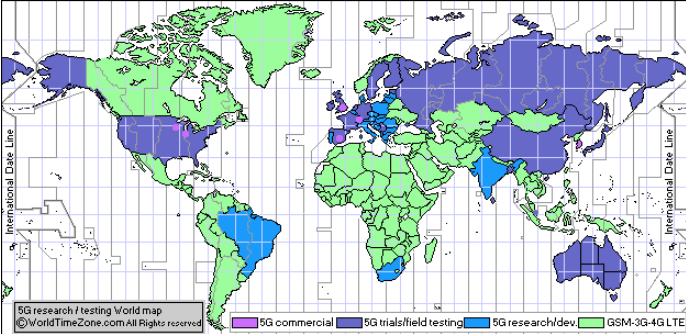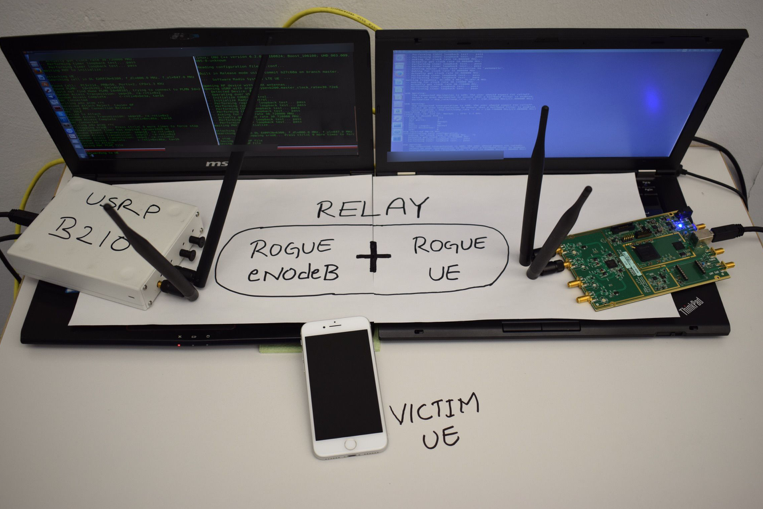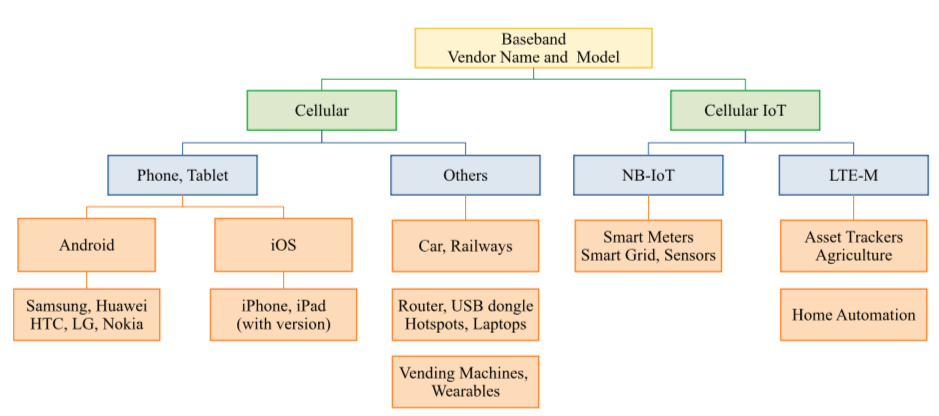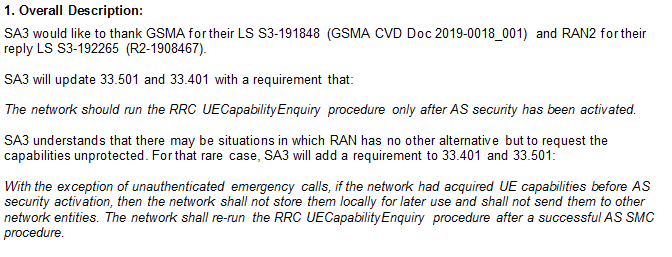The 5G network promises to transform industries and our digital society by providing enhanced capacity, higher data rates, increased battery life for machine-type devices, higher availability and reduced power consumptions. In a way, 5G will act as a vehicle to drive much needed digital transformation race and will push the world into the information age. Also, 5G can be used to replace the existing emergency communication network infrastructures. Many countries are about to launch 5G services commercially as 5G standards have been developed by the 3GPP group, including security procedures. The following map in Figure 1 shows 5G deployments worldwide.

With every generation from 2G to 5G, wireless security (over the air security between mobile phones and cellular towers) has been improving to address various threats. For example, 5G introduced additional security measures to counteract fake base station type of attacks (also known as IMSI catchers or Stingray). Thus, the privacy of mobile subscribers while using 5G networks is much better than previous generations.
However, some of the wireless functionalities that existed in 4G are re-used in 5G. For example, the 3GPP standards group has designed several capabilities in 4G and 5G specifications to support a wide range of applications including smart homes, critical infrastructure, industry processes, HD media delivery, automated cars, etc. In simple words, such kind of capabilities means telling the cellular network that I am a mobile device or a car or IoT device to receive special network services. These capabilities play an essential role for the right operation of the device with respect to its application. In particular, they define the speed, frequency bands, security parameters, application-specific parameters such as telephony capabilities of the device. This allows the network to recognise the application type and accordingly offer the appropriate service. For example, an automated car indicates its Vehicle-2-Vehicle (V2V) support to the network and receives the required parameters to establish communication with surrounding vehicles.
Over the last several months Dr. Ravishankar Borgaonkar together with Altaf Shaik, Shinjo Park and Prof. Jean-Pierre Seifert (SecT, TU Berlin, Germany) experimented with 5G and 4G device capabilities both in the laboratory setting and real networks. This joint study uncovers the following vulnerabilities:
Vulnerabilities in 5G
- A protocol vulnerability in 4G and 5G specification TS 33.410 [2] and TS 33.501 [3] that allows the fake base station to steal information about the device and mount identification attacks
- Implementation vulnerability in cellular network operator equipment that can be exploited during a device registration phase
- A protocol vulnerability in the first release of LTE NB-IoT that affects the battery life of low-powered devices
Potential Attacks
An adversary can mount active or passive attacks by exploiting above three vulnerabilities. In active attacks, he or she can act as a man-in-the-middle attacker to alter device capabilities. Another important point is that such attacks can be carried out using low-cost hardware/software setup. As shown in Figure 2, we use about 2000 USD setup to demonstrate attack feasibility and subsequent impacts.

In particular, we demonstrated following Man-in-the-middle (MiTM) attacks –
- Fingerprinting Attacks – An active adversary can intercept device capabilities and identify the type of devices on a mobile network and intellectually estimate the underlying applications. To demonstrate impact, we performed a Mobile Network Mapping (MNmap) attack which results in device type identification levels as shown in Figure 3.
- Downgrading Attacks – An active adversary can also alter radio capabilities to downgrade network services. For example, VoLTE calls can be denied to a particular mobile phone during the attack.
- Battery Drain Attacks – Starting from 4G networks, there is Power Saving Mode (PSM) defined in the specifications. All cellular devices can request the use of PSM by including a timer T3324 during the registration procedure. When PSM is in use, the 3GPP standard indicates to turn off the radio baseband of the device and thus the radio operations but however, applications on the device (or sensors) can still operate depending on the device settings. An adversary can remove the use of PSM feature from the device capability list during the registration phase, resulting in loss of battery power. In our experiment with NB-IoT device, a power drain attack reduces the battery life by a factor of 5.

More detailed information about above attacks, feasibility and their impact can be found in our full paper, titled “New vulnerabilities in 4G and 5G cellular access network protocols: exposing device capabilities” [4].
Responsible Disclosure
We discovered the vulnerabilities and attacks earlier this year. We followed responsible disclosure procedure and notified GSMA through their Coordinated Vulnerability Disclosure (CVD) Programme. In parallel, we also notified 3GPP who is responsible for designing 4G/5G security specifications and affected mobile network operators.
Research Impact & Countermeasures
We suggested in [4] that 3GPP should consider mandating security protection for device capabilities. In particular, Device Capability Enquiry message carrying radio access capabilities should be accessible/requested by the eNodeB ( a base station in 4G or 5G for example) only after establishing RRC security. This will prevent a MitM attacker from hijacking those capabilities. Consequently, fixing these vulnerabilities will help in mitigating IMSI catcher or fake base station types of attacks against 5G networks.
On the network operator side, eNodeB configuration or implementation should be changed such that a eNodeB should request Device Capability Information only after establishing a radio security association. This is a relatively easy fix and can be implemented by the operators either as a software update or a configurational change on their eNodeBs. Nevertheless, in practice, only a minor number of operators are acquiring capabilities after security setup. The difference among various operators we tested clearly indicates that this could be either an implementation or configuration problem.
While working with GSMA through their Coordinated Vulnerability Disclosure (CVD) Programme, we received confirmation (with CVD-2019-0018 number) last week during the Device Security Group meeting in San Francisco that 3GPP SA3, a group that standardizes 5G security, has agreed to fix the vulnerabilities identified by us in [4]. Following is a snapshot of countermeasures to be added to the 4G [2] and 5G [3] specification respectively –

Even though fixes will be implemented into 4G and 5G standards in coming months, baseband vendors need longer periods (as compared with normal Android or iOS software updates) to update their basebands and hence attackers can still exploit this vulnerability against 4G and 5G devices. A summery of our findings, potential attack, their impact and countermeasures are shown in the following table 1 [4].

In part 2, we will be publishing our work on improving 5G and 4G Authentication and Key Agreement (AKA) protocol to mitigate mobile subscriber privacy issues. Also, we outline AKA protocol related network configuration issues in deployed 4G networks worldwide.
References:
- 5G commercial network world coverage map: 5G field testing / 5G trials / 5G research / 5G development by country (June 15, 2019) https://www.worldtimezone.com/5g.html
- 3GPP. 2018. 3GPP System Architecture Evolution (SAE); Security architecture. Technical Specification (TS) 33.401. 3rd Generation Partnership Project (3GPP). http://www.3gpp.org/DynaReport/33401.htm
- 3GPP. 2018. Security architecture and procedures for 5G System. Technical Specification (TS) 33.501. 3rd Generation Partnership Project (3GPP). http: //www.3gpp.org/DynaReport/33501.htm
- Altaf Shaik, Ravishankar Borgaonkar, Shinjo Park, and Jean-Pierre Seifert. 2019. New vulnerabilities in 4G and 5G cellular access network protocols: exposing device capabilities. In Proceedings of the 12th Conference on Security and Privacy in Wireless and Mobile Networks (WiSec ’19). ACM, New York, NY, USA, 221-231. DOI: https://doi.org/10.1145/3317549.3319728
